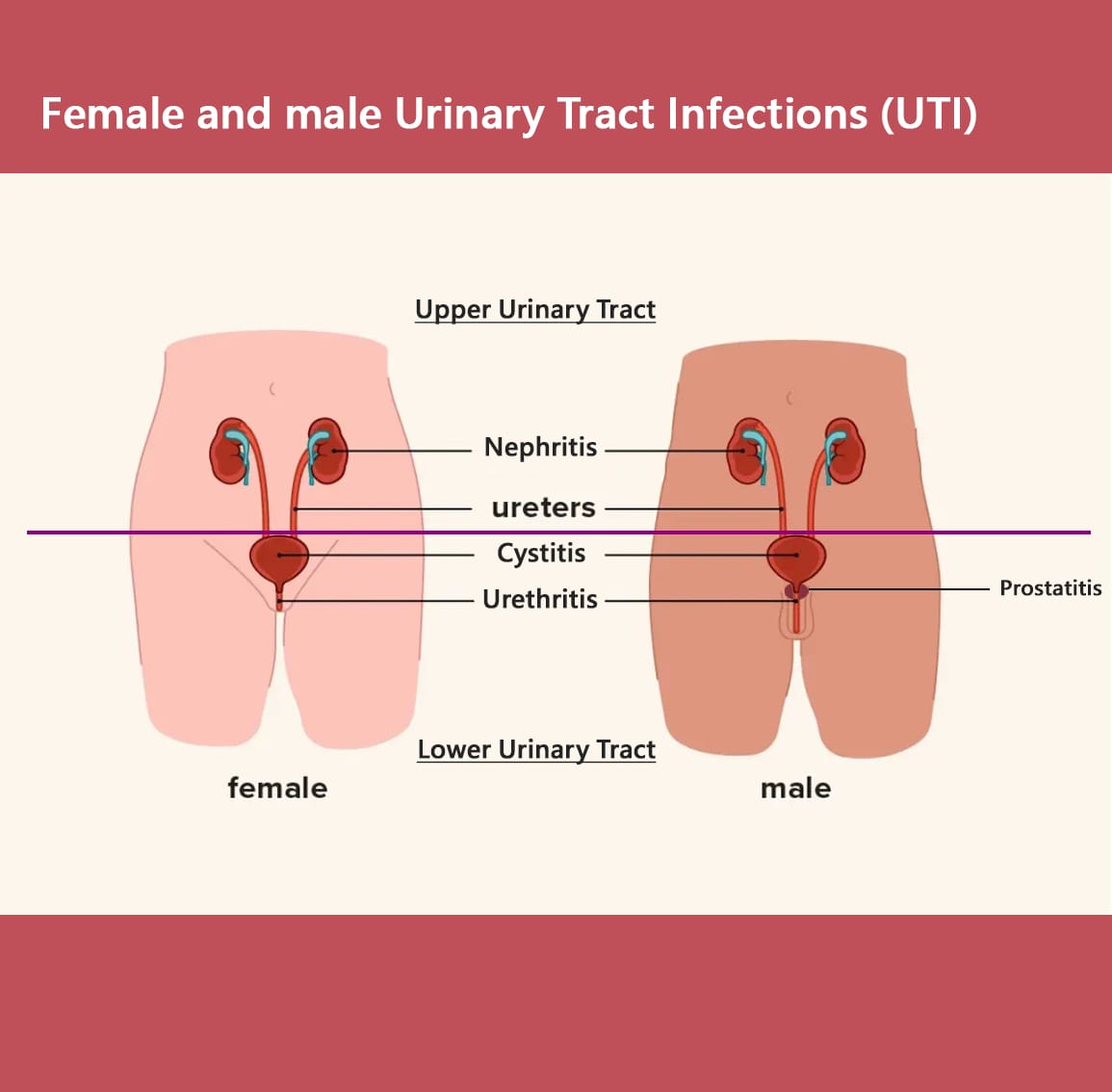
Urinary Tract Infection (UTI)/Bacterial prostatitis
Urinary tract infection is a condition which includes infection of the urethra, bladder, ureters and kidneys. UTIs are very common bacterial infections with a global incidence of 250 million new cases being reported annually. Most UTIs occur in the lower urinary tract which involves the urethra and the bladder. UTIs are caused by bacteria entering the urethra from another site (usually from the skin or the rectum) causing infection.
Pathogens of urinary tract infections
Escherichia coli (E. coli) the most frequently identified pathogen, which accounts for up to 47.15% of all reported UTIs. Other commonly identified pathogens include Staphylococcus aureus, streptococcus agalactiae, Klebsiella spp., Proteus spp., and Enterococcus spp..
UTI for Women and Men
Women are more likely to develop UTI than men and it has been reported that about 50% of women will experience UTI at least once in their lifetime, and up to 25% will develop recurrent UTI, defined by 2 of more UTIs within 6 months, or 3 or more UTIs within 1 year.
Lower urinary tract infection - urethritis and cystitis
Lower urinary tract infections include urethra and bladder infections. The most common symptoms are burning and frequent urination (or the desire to urinate), but no vaginal discharge and no significant pain. These symptoms can be mild or severe and last an average of six days in healthy women, with some pain in the pubic bone and lower back.
What is urethritis?
Urethritis is inflammation of the urethra. Like cystitis, it can be caused by an infection. The difference between urethritis and cystitis is that the result of Urethritis is often caused by sexual behavior, and the transmission of pathogens such as chlamydia or gonorrhea (gonococcus and non-gonococcal urethritis).
What is cystitis?
Cystitis is inflammation of the bladder, usually caused by bacteria. Cystitis is usually not a sexually transmitted disease, but sexual intercourse does increase your risk.
Upper urinary tract infection (acute pelvis, nephritis)
The main pathogenic bacteria are bacteria, which cannot be ruled out because they adhere to the urinary tract mucosa, and ascend to cause kidney infection. In addition to lower urinary tract symptoms, upper urinary tract infection may also cause low back pain, fever, chills, nausea, and vomiting.
Risk factors of getting UTIs:
- Female. Women are more prone to developing UTI than men, due to the shorter urethra (shorter distance for bacteria to travel up to the bladder), and the close proximity of the urethral opening to the anus.
- Being sexually active. Penetrative sex can bring bacteria from the vulva into the urethra.
- Not drinking enough fluids.
- Urinary tract obstruction. Conditions such as kidney stones or enlarged prostate (in men) will block the normal flow and causes a buildup of urine.
- Weakened immune system.
- Use of urinary catheter.
- Recent surgery to urinary tract.
Bacterial prostatitis in Men
Men with UTI can also develop bacterial prostatitis (infection of the prostate gland). Prostatitis is a common urinary tract condition, with 50% of men developing prostatitis at some point in their lives. E. coli is the most common cause of bacterial prostatitis and is responsible for more than 50% of reported cases. Other commonly identified pathogens include Pseudomonas aeruginosa, Klebsiella spp., Enterococcus spp., Enterobacter spp., Proteus spp., Serratia spp., and other STDs.
Risk factor of developing bacterial prostatitis:
- UTI including infection of the urethra and bladder
- Had prostatitis before
- Use of urinary catheter
- Weakened immune system
- Had prostate biopsy
- Have an enlarged prostate or prostate cancer
Prevention of UTI
You can lower your risk of getting UTIs by:
- Stay hydrated, drink enough water and urinate regularly.
- Treat the underlying conditions, e.g. renal stones or enlarged prostate
- Maintain good personal hygiene
- Urinate after sex
- Wipe front to back (for women)
- Avoid wearing tight-fitted trousers or underwear
(Text Only)

